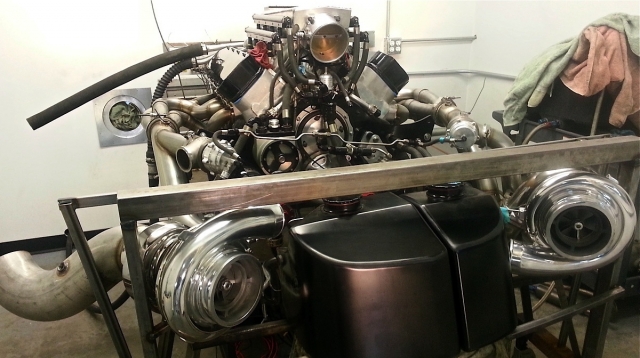Today’s dynos have been getting smacked around pretty good as engine builders push boost levels higher and higher on bigger and bigger engines. We’ve already seen what a 2,500-horsepower twin-turbo big-block designed for street/track day outings can do to a dyno cell. Now, thanks to the Horsepower Connection and RPM Performance in Lake Havasu City, Arizona, we have an insight into a 434ci small-block with twin turbos slurping methanol.
“It’s an animal. The motor plate started flexing and moving on the dyno,” reports Brian Macy. “We had to make a strut assembly to limit engine movement.”
The all-alloy bullet built by Jason Pettis was pumping out more than 2,100 horsepower on just 16 pounds of boost when the team chose to shut it down for further evaluation.
“It make more power than we thought it could on low boost,” says Macy, who was helping with the tuning and pointed to the 2,137-horsepower reading at 6,900 rpm. “We just wanted to get a safe baseline to go down the track.”
The engine is based on a CN billet block fitted with a Bryant cranks, GRP rods, Ross pistons (9.5:1 compression ratio) and a Dailey dry sump system. On top are CFE SBX heads, which were first developed for Pro Stock trucks in the late ’90s. They’re dressed with Jesel rockers and topped with a CFE intake that sports 16 200-pound injectors from Injector Dynamics and an Accufab 105mm throttle body. Other vital equipment includes a Bullet camshaft, Waterman fuel pump, MSD Pro Mag 44 with Power Grid timing controls and a FAST XFI ECU. Providing the boost is a pair of Garrett 88mm turbos mounted to headers fabricated by Brian Smith.
The engine is destined for the PSCA Extreme Drag Radial Camaro owned and driven by Steve DeYoung.
“It runs on methanol and should run in the 6s,” says Macy. “It’s capable of 40 pounds of boost.”
Macy notes it took the team 18 hours just to get the engine hooked up to the dyno and ready for a pull. In addition to sorting out the motor plate issues, the team also addressed wiring and valve adjustments along with changing fuel pumps mid course in the testing.
“We were sneaking up on everything because we didn’t want to just start beating on it,” says Macy. “It’s definitely not the type of engine you grab and start doing dyno pulls.”
And when Donnie Bonnahoom at RPM Performance started making the pulls, there was too much racket coming through the walls.
“The engine noise started shutting off my laptop,” says Macy. “So we had to make a noise barrier to keep the laptop happy.”























